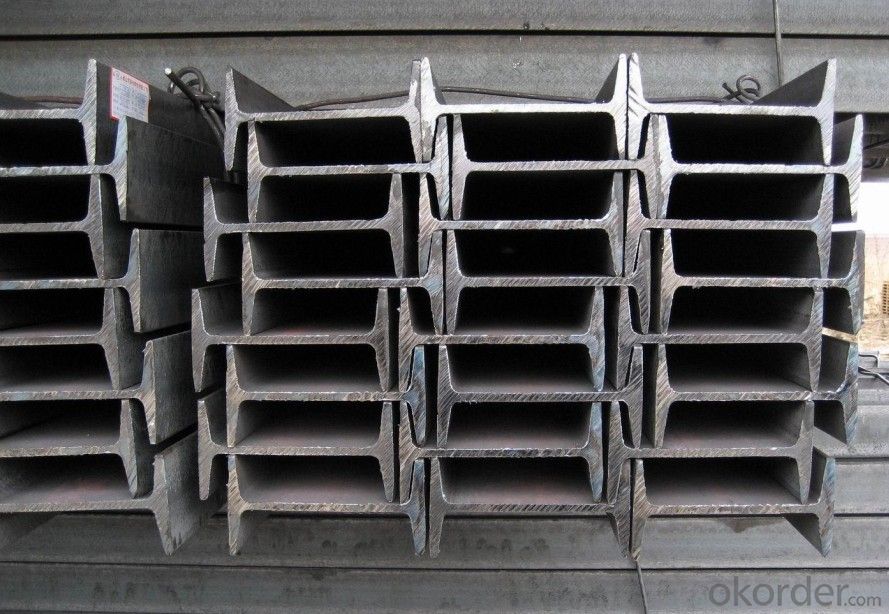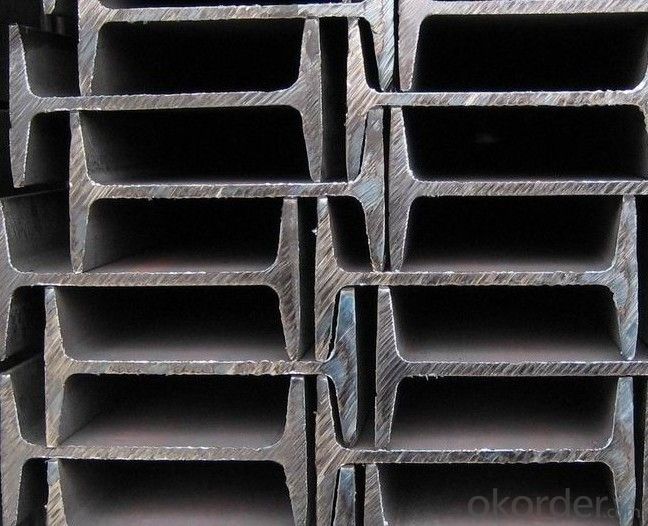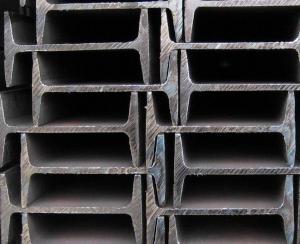High Quality IPE Beam with Material Grade GB-Q235
- Loading Port:
- Tianjin
- Payment Terms:
- TT OR LC
- Min Order Qty:
- 25 m.t.
- Supply Capability:
- 10000 m.t./month
OKorder Service Pledge
OKorder Financial Service
You Might Also Like
Product Description:
OKorder is offering high quality Hot Rolled Steel I-Beams at great prices with worldwide shipping. Our supplier is a world-class manufacturer of steel, with our products utilized the world over. OKorder annually supplies products to European, North American and Asian markets. We provide quotations within 24 hours of receiving an inquiry and guarantee competitive prices.
Product Applications:
1. Supporting members, most commonly in the house raising industry to strengthen timber bears under houses. Transmission line towers, etc
2. Prefabricated structure
3. Medium scale bridges
4. It is widely used in various building structures and engineering structures such as roof beams, bridges, transmission towers, hoisting machinery and transport machinery, ships, industrial furnaces, reaction tower, container frame and warehouse etc.
Product Advantages:
OKorder's Steel I-Beams are durable, strong, and resist corrosion.
Main Product Features:
· Premium quality
· Prompt delivery & seaworthy packing (30 days after receiving deposit)
· Corrosion resistance
· Can be recycled and reused
· Mill test certification
· Professional Service
· Competitive pricing
Product Specifications:
1. Invoicing on theoretical weight or actual weight as customer request
2. Standard: EN10025, GB Standard, ASTM
3. Grade: Q235B, Q345B, SS400, ASTM A36, S235JR, S275JR
4. Length: 5.8M, 6M, 9M, 12M as following table
5. Sizes: 80mm-270mm
Dimensions(mm) | |||||
h | b | s | t | Mass Kg/m | |
IPE80 | 80 | 46 | 3.80 | 5.20 | 6.00 |
IPE100 | 100 | 55 | 4.10 | 5.70 | 8.10 |
IPE120 | 120 | 64 | 4.80 | 6.30 | 10.40 |
IPE140 | 140 | 73 | 4.70 | 6.90 | 12.90 |
IPE160 | 160 | 82 | 5.00 | 7.40 | 15.80 |
IPE180 | 180 | 91 | 5.30 | 8.00 | 18.80 |
IPE200 | 200 | 100 | 5.60 | 8.50 | 22.40 |
IPE220 | 220 | 110 | 5.90 | 9.20 | 26.20 |
IPE240 | 240 | 120 | 6.20 | 9.80 | 30.70 |
IPE270 | 270 | 135 | 6.60 | 10.20 | 36.10 |
FAQ:
Q1: Why buy Materials & Equipment from OKorder.com?
A1: All products offered byOKorder.com are carefully selected from China's most reliable manufacturing enterprises. Through its ISO certifications, OKorder.com adheres to the highest standards and a commitment to supply chain safety and customer satisfaction.
Q2: How do we guarantee the quality of our products?
A2: We have established an advanced quality management system which conducts strict quality tests at every step, from raw materials to the final product. At the same time, we provide extensive follow-up service assurances as required.
Q3: How soon can we receive the product after purchase?
A3: Within three days of placing an order, we will begin production. The specific shipping date is dependent upon international and government factors, but is typically 7 to 10 workdays.
Images:


- Q:What are the common testing methods used to verify the quality of steel I-beams?
- Steel I-beams are subject to various testing methods to ensure their quality. These methods ascertain that the beams meet the necessary standards and specifications in terms of strength, durability, and safety. 1. Tensile Testing: In this method, steel I-beams undergo controlled force to measure their strength and elasticity. The beams are pulled until they reach their breaking point, determining their maximum force-bearing capacity. This test helps determine if the beams possess the requisite tensile strength. 2. Hardness Testing: The resistance of steel I-beams to indentation or scratching is measured through hardness testing. Common methods, such as the Brinell, Rockwell, and Vickers tests, are used. By applying a known force using a specific indenter, the material's hardness can be determined. This test assesses the beam's ability to resist wear and deformation. 3. Impact Testing: The ability of steel I-beams to endure sudden forces or impacts is evaluated through this method. The beams are either struck with a pendulum or dropped from a certain height, and the energy absorbed during impact is measured. This test determines the beam's toughness and resistance to sudden loading. 4. Ultrasonic Testing: High-frequency sound waves are employed in ultrasonic testing to detect any internal defects or inconsistencies within the steel I-beams. A probe placed on the beam's surface sends sound waves through the material. Any irregularities like cracks or voids are reflected back to the probe and analyzed. This non-destructive test identifies hidden flaws that may compromise the beam's structural integrity. 5. Visual Inspection: Trained inspectors visually examine the steel I-beams for any visible defects in this basic method. Surface cracks, welding irregularities, or corrosion are some of the defects checked for during this inspection. Visual inspection helps identify any issues that may impact the overall quality of the beams. By employing these testing methods individually or in combination, steel I-beams can be ensured to meet the required quality standards. Proper testing guarantees the structural integrity, safety, and reliability of these crucial construction components.
- Q:How do steel I-beams compare to other structural materials like wood or concrete?
- Steel I-beams are widely acknowledged as superior to other structural materials such as wood or concrete for several reasons. To begin with, steel I-beams possess exceptional strength and durability. With a high tensile strength, steel can bear heavy loads and resist deformation, making it ideal for constructing large buildings or bridges where structural integrity is paramount. In contrast, wood is susceptible to warping, rotting, and insect damage, while concrete is prone to cracking and erosion over time. In addition, steel I-beams offer greater design flexibility. They can be fabricated into different shapes and sizes, enabling innovative architectural designs and efficient use of space. This versatility is particularly vital when constructing large-span structures or buildings with complex geometries. Wood, on the other hand, has limitations in terms of load-bearing capacity and requires additional supporting elements for larger spans. Concrete also lacks flexibility in design, usually necessitating formwork and curing time. Furthermore, steel I-beams are renowned for their fire resistance. Unlike highly combustible wood, steel does not burn or contribute to the spread of flames. This makes steel I-beams a safer choice in terms of fire protection and potentially life-saving in the event of a fire. Moreover, steel I-beams boast a longer lifespan compared to wood or concrete. Steel is resistant to moisture, pests, and decay, resulting in minimal maintenance requirements over time. Conversely, wood necessitates regular treatment and protection against insects and moisture, while concrete can deteriorate due to weathering and chemical reactions. In terms of cost, steel I-beams may initially incur higher expenses than wood or concrete, but they offer long-term cost savings due to their durability and low maintenance requirements. Additionally, steel is a recyclable material, making it an environmentally friendly choice. Overall, steel I-beams excel in terms of strength, flexibility, fire resistance, longevity, and cost-effectiveness compared to wood and concrete. These qualities establish steel I-beams as the preferred choice for numerous structural applications, ranging from residential buildings to large-scale infrastructure projects.
- Q:What does "No. ten I-beam" mean? How is the number of I-beam divided?
- In the national standard hot rolled steel I-beam series, the code number of I-beam is divided according to the section height. A numerical representation of a centimeter by the height of a cross. For example: No. fourteen I-beam refers to the height of I-beam is 140 mm, and so on.
- Q:Are there any special considerations when designing with steel I-beams for long-span structures?
- Yes, there are several special considerations when designing with steel I-beams for long-span structures. Firstly, the weight and load-bearing capacity of the I-beams must be carefully calculated to ensure they can support the anticipated loads. Long-span structures often experience higher loads and stresses due to their larger spans, so it is crucial to select I-beams with sufficient strength and stiffness. Secondly, the deflection of the I-beams must be carefully controlled to prevent excessive sagging or bending. This can be achieved by using thicker and stronger beams, or by incorporating additional support elements such as trusses or cross beams. Thirdly, the thermal expansion and contraction of steel must be taken into account. Long-span structures are more susceptible to temperature changes, which can cause the steel beams to expand or contract. Proper allowances for thermal movement must be made to prevent structural issues or damage. Additionally, the connections between the I-beams and other structural elements must be carefully designed to ensure proper load transfer and structural integrity. Special attention should be given to the connection details to ensure they can accommodate the expected loads and account for any potential movement or deflection of the beams. Finally, the overall structural stability and resistance to lateral forces, such as wind or seismic loads, must be carefully considered. Long-span structures are more vulnerable to these forces, and proper bracing and structural reinforcement must be incorporated to ensure the overall stability and safety of the design. In summary, designing with steel I-beams for long-span structures requires careful consideration of weight, load-bearing capacity, deflection, thermal expansion, connections, and overall stability. By addressing these special considerations, engineers can create safe and efficient designs for long-span structures using steel I-beams.
- Q:What are the common installation methods for steel I-beams?
- There are several common installation methods for steel I-beams, depending on the specific requirements of the project: 1. Welding: One of the most common installation methods is welding. This involves joining the I-beams to other structural elements or supports by using a welding process. Welding provides a strong and durable connection and is often used in construction projects where the I-beams need to support heavy loads. 2. Bolting: Another common method is bolting the I-beams to other structures. This involves using bolts, washers, and nuts to secure the I-beams in place. Bolting offers the advantage of being easily removable, making it useful in projects that may require future modifications or disassembly. 3. Crane lifting: For larger or heavier I-beams, crane lifting is often used for installation. This method involves using a crane to hoist and position the I-beams into place. Crane lifting is commonly employed in large-scale construction projects such as high-rise buildings or bridges. 4. Anchoring: In some cases, I-beams may need to be anchored to the ground or foundation to provide additional stability. This can be achieved by using anchor bolts or other anchoring systems that secure the I-beams to the ground. Anchoring is particularly important in seismic-prone areas to ensure structural integrity during earthquakes. 5. Bridging: In situations where multiple I-beams need to be connected together to form longer spans, bridging is utilized. Bridging involves connecting the flanges of adjacent I-beams using plates or brackets, creating a continuous structural system. This method is often used in building construction to create longer beams that can support larger loads. It is important to note that the specific installation method for steel I-beams may vary depending on factors such as the structural design, load requirements, and local building codes. Consulting with structural engineers or construction professionals is crucial to ensure proper and safe installation.
- Q:Are there any alternatives to steel I-beams?
- Yes, there are several alternatives to steel I-beams. Some popular alternatives include engineered wood beams, such as laminated veneer lumber (LVL) and glued laminated timber (glulam), which provide similar strength and load-bearing capacity as steel. Another alternative is reinforced concrete beams, which offer high durability and can be customized to fit specific design requirements. Additionally, composite beams made of materials like fiberglass or carbon fiber reinforced polymers (FRP) are gaining popularity due to their lightweight nature and corrosion resistance.
- Q:How do steel I-beams perform in areas with high humidity or moisture content?
- Areas with high humidity or moisture content can pose a challenge for steel I-beams. The durability and corrosion resistance of steel make it a suitable material, but prolonged exposure to moisture can still have a negative impact on their performance and lifespan. The risk of corrosion in humid or moist areas is higher due to the presence of moisture in the air. Moisture reacts with oxygen and causes rust formation, which weakens the structural integrity of the I-beams over time. To minimize this risk, it is crucial to implement proper maintenance and preventive measures. Regular inspections should be conducted to identify signs of corrosion or damage, and prompt action should be taken to address them. Applying protective coatings or paint can create a barrier between the steel and moisture, reducing the likelihood of corrosion. Moreover, adequate ventilation and moisture control measures should be in place in such areas. These measures help reduce overall moisture levels and limit the exposure of steel I-beams to moisture. In conclusion, although steel I-beams generally perform well in areas with high humidity or moisture content, it is important to take appropriate precautions to prevent corrosion and ensure their long-term durability. Regular maintenance, protective coatings, and moisture control measures are essential to ensure optimal performance in such environments.
- Q:How do I connect two lengths of I-beam?
- No oblique 45 degrees (of course, with better) by manual arc welding in general, definition of welding weld is the binding force of atomic force, no problem.
- Q:What are the different types of steel used in manufacturing I-beams?
- There are several different types of steel commonly used in the manufacturing of I-beams. The choice of steel depends on various factors such as the strength requirements, load-bearing capacity, corrosion resistance, and cost-effectiveness. 1. Carbon Steel: Carbon steel is the most commonly used type of steel for manufacturing I-beams. It is known for its high strength and durability. Carbon steel I-beams are typically made from low carbon steel, which offers good weldability and formability. They are suitable for general construction purposes and offer an affordable option. 2. Alloy Steel: Alloy steel is another popular choice for manufacturing I-beams, especially when higher strength and toughness are required. Alloy steels are made by adding various alloying elements, such as manganese, chromium, nickel, or molybdenum, to carbon steel. This enhances the mechanical properties of the steel, making it more resistant to wear, impact, and fatigue. 3. Stainless Steel: Stainless steel I-beams are used when corrosion resistance is a critical factor. Stainless steel contains chromium, which forms a passive oxide layer on the surface, protecting it from corrosion. This makes stainless steel I-beams suitable for applications in humid or corrosive environments, such as marine or chemical industries. 4. High-Strength Low-Alloy (HSLA) Steel: HSLA steel is a type of alloy steel that provides a higher strength-to-weight ratio compared to carbon steel. It contains small amounts of alloying elements, such as copper, nickel, or vanadium, which enhance the strength while maintaining good weldability and formability. HSLA steel I-beams are commonly used in heavy-duty construction and infrastructure projects. 5. Weathering Steel: Weathering steel, also known as Corten steel, is a type of steel alloy that develops a protective rust-like appearance when exposed to the elements. This natural corrosion-resistant layer eliminates the need for painting or coating, making it suitable for outdoor structures like bridges or building facades. Weathering steel I-beams offer durability and a unique aesthetic appeal. It is important to consider the specific requirements of the application when selecting the type of steel for manufacturing I-beams. Factors such as strength, corrosion resistance, cost, and availability should be taken into account to ensure the optimal choice of steel for the desired application.
- Q:Can steel I-beams be used in curved structures?
- Curved structures can indeed utilize steel I-beams. Although I-beams are typically employed in straight applications, they can be flexed to accommodate the design specifications of a curved structure. This involves a method called cold-bending, where the I-beam is gradually shaped to the desired form using specialized machinery. Through cold-bending, steel I-beams can take on various radii and curves, thus rendering them appropriate for employment in curved structures like arches, domes, and curved roofs. It is pertinent to mention that the bending process may lead to some deformation or distortion in the I-beam's cross-section. Nevertheless, this can be mitigated by implementing proper techniques and ensuring the structural soundness of the curved steel I-beams.
1. Manufacturer Overview |
|
|---|---|
| Location | |
| Year Established | |
| Annual Output Value | |
| Main Markets | |
| Company Certifications | |
2. Manufacturer Certificates |
|
|---|---|
| a) Certification Name | |
| Range | |
| Reference | |
| Validity Period | |
3. Manufacturer Capability |
|
|---|---|
| a)Trade Capacity | |
| Nearest Port | |
| Export Percentage | |
| No.of Employees in Trade Department | |
| Language Spoken: | |
| b)Factory Information | |
| Factory Size: | |
| No. of Production Lines | |
| Contract Manufacturing | |
| Product Price Range | |
Send your message to us
High Quality IPE Beam with Material Grade GB-Q235
- Loading Port:
- Tianjin
- Payment Terms:
- TT OR LC
- Min Order Qty:
- 25 m.t.
- Supply Capability:
- 10000 m.t./month
OKorder Service Pledge
OKorder Financial Service
Similar products
New products
Hot products
Related keywords



























